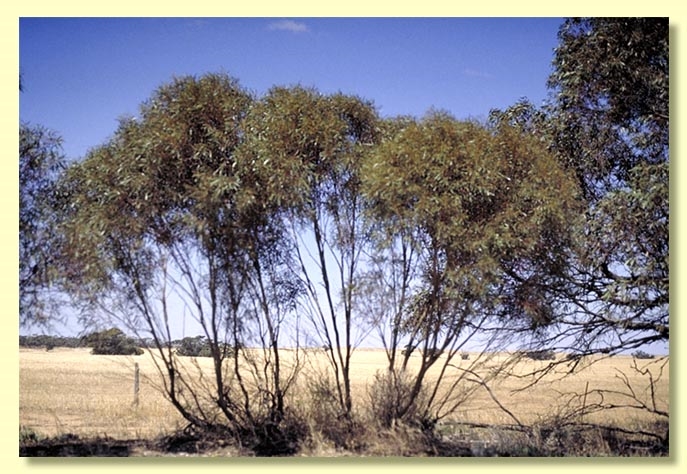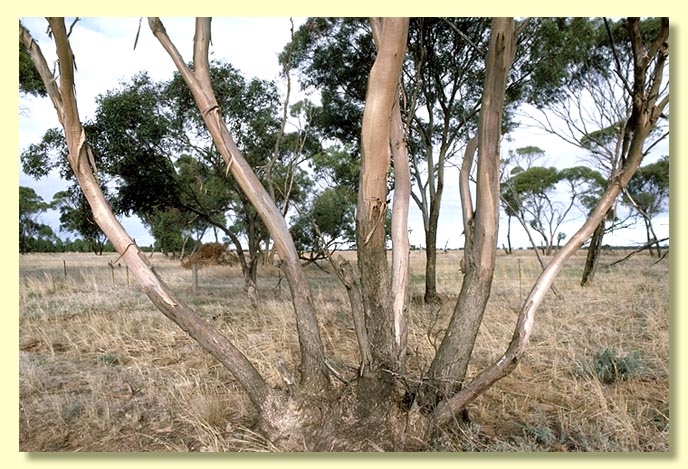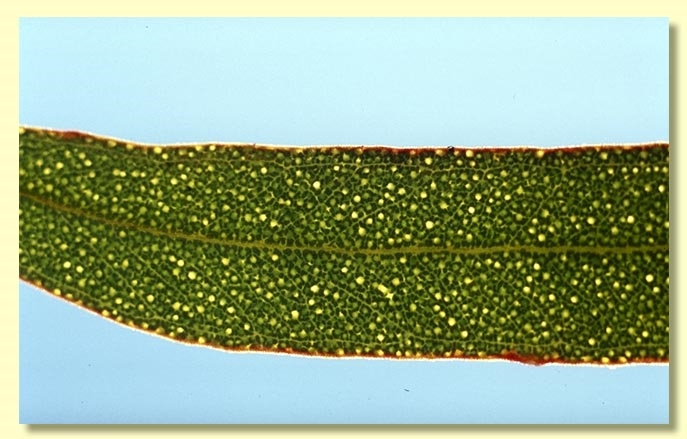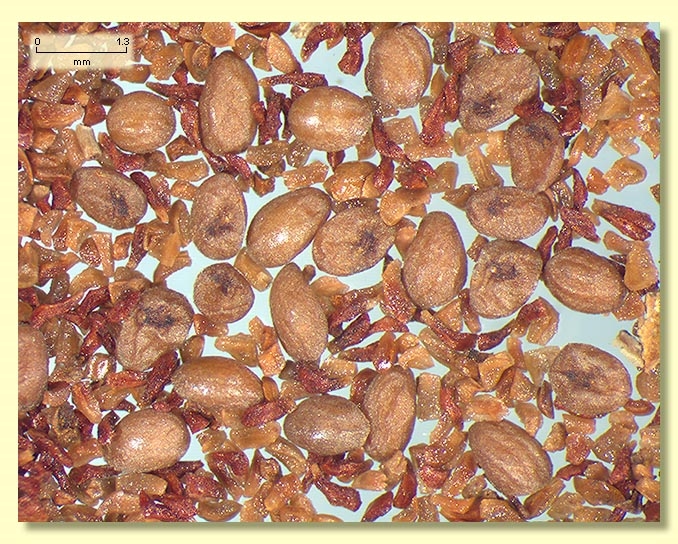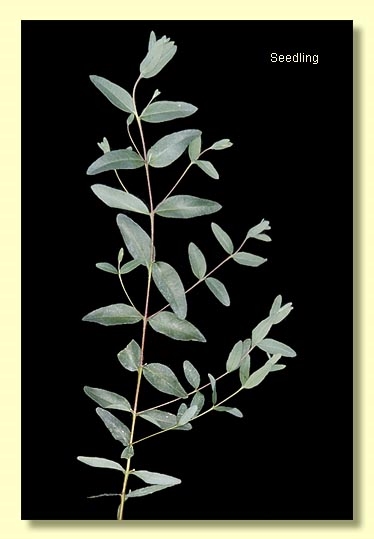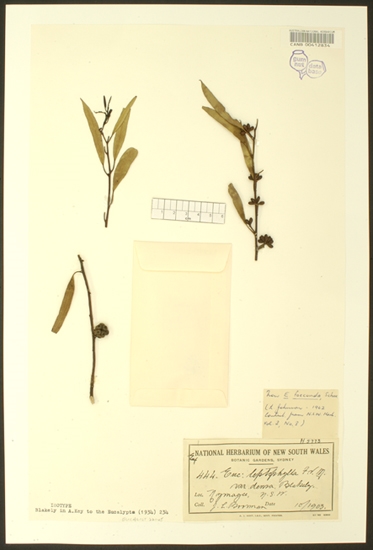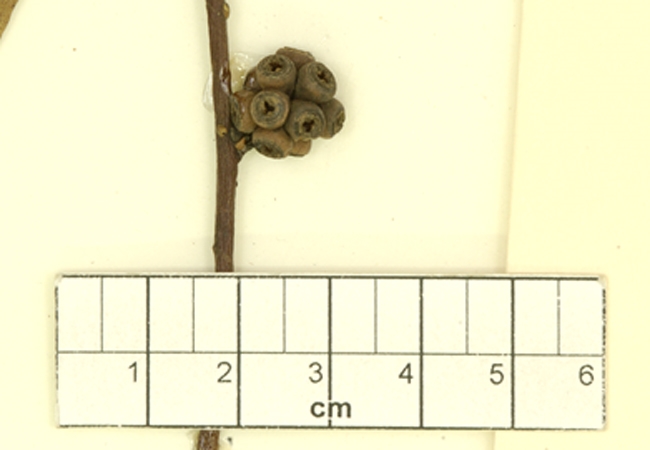Euclid - Online edition
Eucalyptus leptophylla
Eucalyptus | Symphyomyrtus | Bisectae | Destitutae | Porantherae | Ovatae
Bark smooth, grey, white, light pinkish grey or salmon, sometimes becoming granular with age, shedding in long strips.
Branchlets lacking oil glands in the pith.
Juvenile growth (coppice or field seedlings to 50 cm): stems usually rounded in cross-section, glaucous or non-glaucous; juvenile leaves sessile, opposite (sometimes a few sub-opposite), becoming alternate and petiolate at upper nodes, elliptic-oblong to lanceolate, 1.5–6 cm long, 0.5–2.5 cm wide, glaucous at first then dull blue-green.
Adult leaves alternate, petiole 0.4–1.3 cm long; blade narrowly lanceolate to oblong to linear or falcate, 3–9 cm long, 0.3–1.3 cm wide, base tapering to petiole, concolorous, glossy, green, side-veins greater than 45° to midrib, densely to very densely reticulate, intramarginal vein parallel to and just within margin, oil glands mostly intersectional.
Inflorescence axillary unbranched, peduncles 0.3–1 cm long, buds 7 to 13 per umbel, usually pedicellate, rarely sessile (pedicels 0–0.4 cm long). Mature buds fusiform to ovoid (0.4–0.7 cm long, 0.25–0.35 cm wide), green to yellow to red, scar present, operculum usually bluntly conical (0.2–0.35 cm wide), stamens inflexed, anthers cuneate-cuboid, adnate to filament apex (rigidly basifixed), dehiscing by sub-terminal pores, a few of the innermost stamens imperfectly formed, style long and straight, rarely with an obvious apical twist, stigma tapered, locules 3 or 4, the placentae each with 4 vertical rows of ovules. Flowers creamy white.
Fruit pedicellate (pedicels 0.1–0.4 cm long), cup-shaped, shortly barrel-shaped or hemispherical, 0.3–0.6 cm long, 0.3–0.6 cm wide, disc pale, level or descending, valves 3 or 4, more or less enclosed or near rim level.
Seeds brown, 0.8–2 mm long, flattened-ovoid, sometimes with furrows on the virtually smooth dorsal surface, hilum ventral.
Cultivated seedlings (measured at node 10): cotyledons Y-shaped (bisected); stems rounded in cross-section, sometimes glaucous, smooth to slightly warty; leaves sessile, opposite for 7–16 nodes then alternate, ovate-elliptic to narrowly oblong, 1–4.5 cm long, 0.5–2 cm wide, base tapering to rounded, never amplexicaul, grey to grey-green or slightly glaucous above and quite glaucous below.
Flowering has been recorded in January, February, March, November and December.
It is a smooth-barked mallee occurring westwards from Euabalong in central New South Wales and Wedderburn in Victoria through mallee areas of southern South Australia to the Gawler Ranges. In the Great Victoria Desert of South Australia and Western Australia the picture is less clear. Some mallees resemble E. leptophylla in adult habit and seedlings whilst other mallees have a stocking of rough bark and seedlings with leaves that are rounded with amplexicaul bases and much wartier stems, i.e. they approach E. horistes. It is not clear how far west E. leptophylla occurs in Western Australia.
Eucalyptus leptophylla belongs in Eucalyptus subgenus Symphyomyrtus section Bisectae subsection Destitutae because the buds have two opercula, cotyledons are Y-shaped and branchlets lack oil glands in the pith. Within this subsection E. leptophylla belongs to a group of about 16 species, series Porantherae, that are further characterised by having anthers completely adnate to the staminal filaments, strongly inflexed stamens, densely reticulate leaves with intersectional oil glands, and by the fruit with a distinct thick rim that includes a whitish descending disc. The small, glossy leaves of species in series Porantherae may result in confusion with species in series Heterostemones. The fruit alone usually distinguish the series. The fruit of species in series Heterostemones are thin-rimmed.
E. leptophylla is the only species in series Porantherae found in eastern Australia. In the Great Victoria Desert it can be distinguished from both E. horistes and the smooth-barked tree E. salicola by the bluntly conical (not beaked) operculum, and by the juvenile growth—elliptic-oblong leaves in E. leptophylla and orbicular leaves and warty stems in the other two species. E. rigidula, another Western Australian species in this group that extends east to the westerly fringes of the Great Victoria Desert, is a smooth-barked mallee with linear green juvenile leaves.
A specimen (Lepschi 4576) recently collected in Western Australia north-east of Koolyanobbing just south of the Helena and Aurora Ranges is a good match for Eucalyptus leptophylla var. floribunda Blakely. This variety is noted for its glaucous branchlets in the crown, an unusual feature for E. leptophylla as it is typically known further east. It needs to be collected more and seedlings grown to check juvenile characters.

